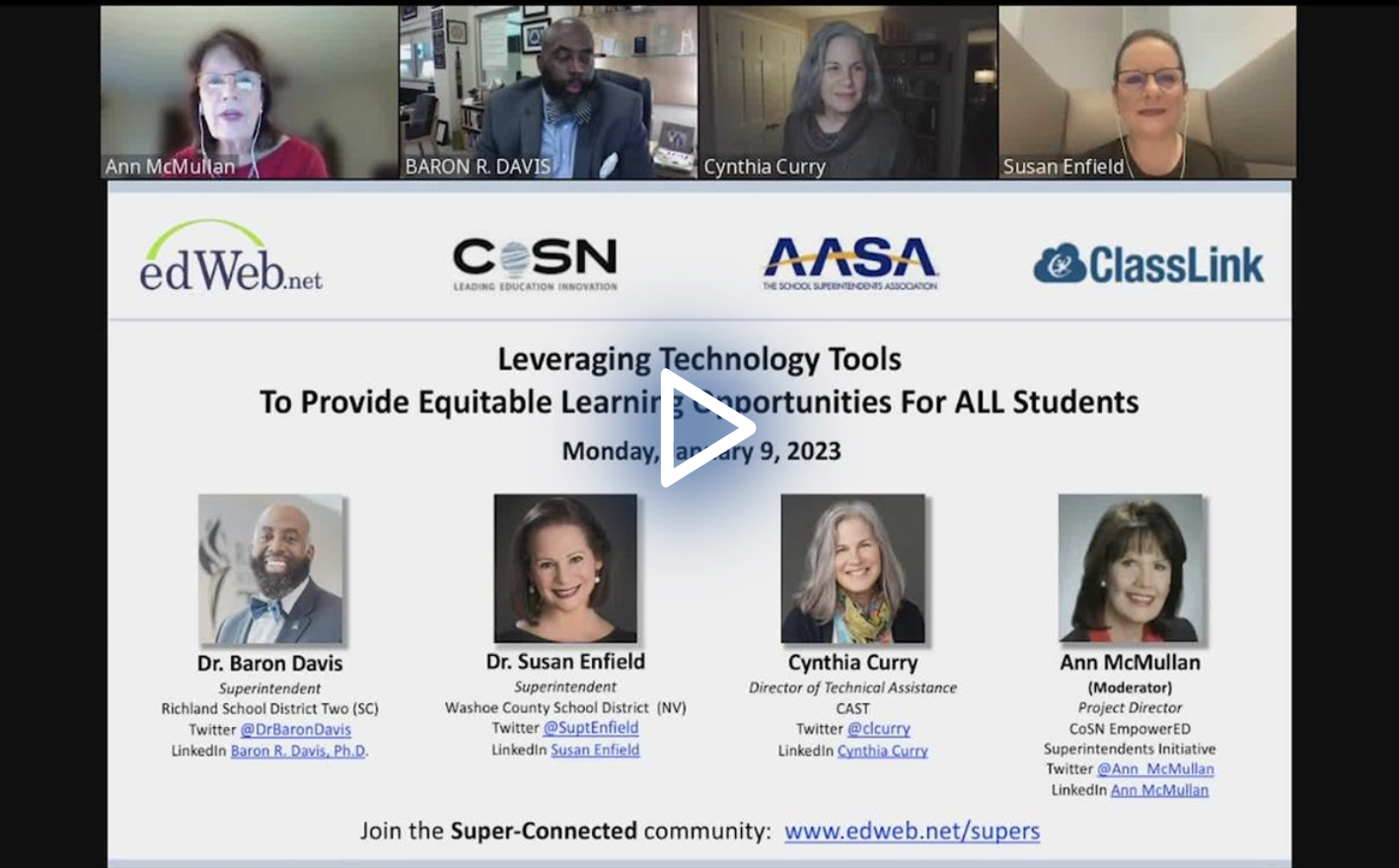5 Steps For Addressing Equitable Learning Using Technology
Watch the Recording Listen to the Podcast
This edLeader Panel is presented by CoSN and AASA.
Sponsored by ClassLink
While giving all students access to high-speed internet and a working computer are strong steps towards creating equitable learning opportunities, there’s one area schools often miss: technical assistance for students with learning differences.
During the edLeader Panel, “Leveraging Technology Tools to Provide Equitable Learning Opportunities for ALL Students,” two superintendents and the director of technical assistance at CAST discussed CoSN’s Five Compelling Steps to Address Accessibility.
Step 1: Stay current with state and federal legislation
This does not mean waiting for legislation and regulations to be passed and reacting to them. Superintendents should have staff actively monitoring potential changes, comparing current district policies, and determining what the district will need to do if the new law is passed.
In addition, district staff should get involved with local and state (and even federal) committees and organizations that are discussing, evaluating, and forming policy related to student accessibility. This allows the educator’s voice to be a part of the discussion and gives the school a heads-up on what might be coming. Smaller schools and districts that can’t hire a lobbyist or have staff devoted to legislation should join together with similar districts so they can stay ahead of legislative changes as well.
Step 2: Develop and communicate a school systemwide policy for accessibility including guidelines for purchasing
Equity policies are great, but they don’t often talk about the role of assistive technology. This needs to be codified so that administrators and staff are thinking about every student’s needs as they develop curricula, purchase resources, etc. Subject area and special ed teachers should be part of the RFP process to make sure that what they’re choosing is as accessible as possible for all students.
In addition, administrators shouldn’t wait to buy all of the assistive technology until they think there is a need. There are some items, like larger monitors, they can have ready. Finally, all policies should address sustainability, including the repair and replacement of the tech.
Step 3: Build staff capacity
It isn’t enough for staff to know the words of the equity policies—they must understand the why and integrate the policies into all of their work. All equity efforts should be systemic and manifest in every purchase and decision. One key is approaching education with the idea that all students are uniquely gifted and deserve the best possible education and to focus on their individual needs.
Step 4: Conduct regular accessibility audits
What gets measured is more likely to get attention, so access to assistive technology should become a part of district monitoring reports. However, this should not only be about compliance with regulations but also about doing what’s fundamentally right for children.
Step 5: Set expectations. Model accountability.
As with every other district policy, accountability begins with the administration communicating its importance across all available channels and demonstrating it through leadership.
There are resources available to help with drafting equitable education opportunities:
- CITES (Center on Inclusive Technology & Education Systems) from CAST helps school districts “create and sustain inclusive technology systems that serve all students.” The website includes a framework of evidence-based practices.
- UDL (Universal Design for Learning), also from CAST, offers guidelines for developing challenging and meaningful educational opportunities for all students.
Learn more about this edWeb broadcast, “Leveraging Technology Tools to Provide Equitable Learning Opportunities for ALL Students,” presented by CoSN and AASA, and sponsored by ClassLink.
Watch the Recording Listen to the Podcast
Join the Community
Super-Connected is a free professional learning community for school superintendents, district leadership, and aspiring district leaders.


ClassLink empowers your students and teachers with instant access to their learning resources. ClassLink® LaunchPad includes a library of over 6,000 single sign-on apps and instant links to file folders at school and on Google, Office 365, Dropbox, and Box cloud drives. ClassLink Roster Server easily and securely delivers class rosters to any publisher using open technology standards. ClassLink Analytics gives decision makers the usage data they need. ClassLink is ideal for 1 to1 and BYOD initiatives.
Blog post by Stacey Pusey, based on this edLeader Panel






Comments are closed.